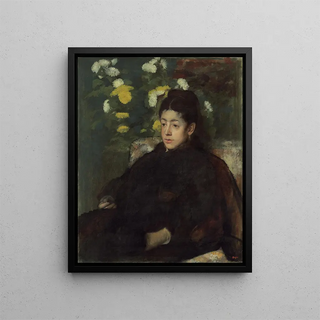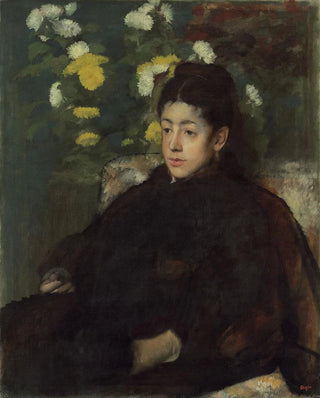Art print | Mademoiselle Malo - Edgar Degas


View from behind

Frame (optional)
In the fascinating world of impressionist art, "Mademoiselle Malo" by Edgar Degas stands out for its delicacy and emotional depth. This artwork, which captures a fleeting moment in the life of a young woman, immerses us in the intimacy of a scene where beauty and melancholy meet. Through Degas's attentive gaze, we discover not only the subject but also the atmosphere surrounding her—a mood of sophistication and mystery. The art print Mademoiselle Malo - Edgar Degas invites us to explore this subtle interaction between the artist and his model, while awakening our curiosity about the stories each character can tell.
Style and uniqueness of the work
Degas's style is recognizable among a thousand, and "Mademoiselle Malo" is a perfect example. The artist combines traditional painting techniques with an innovative approach, playing with light and shadow to bring his subjects to life. In this piece, fluid brushstrokes and delicate colors contribute to creating an atmosphere that is both lively and dreamlike. The young woman, at the center of the composition, appears both present and distant, as if lost in her thoughts. Degas excels in capturing the psychology of his models, and this work is no exception. Every detail, from the movement of the dress to the expression on her face, reveals an underlying story—a call to contemplate human emotions in their complexity.
The artist and his influence
Edgar Degas, an emblematic figure of the impressionist movement, managed to leave his mark on his era with his unique vision of art. Born in 1834, he was initially influenced by classical masters before turning toward a more modern aesthetic, incorporating elements of daily life into his works. His fascination with movement—whether in dance, urban life, or portraits—allowed him to distinguish himself from his contemporaries. Degas also experimented with various mediums, ranging from painting to sculpture, enriching his artistic repertoire. His influence endures today, inspiring many artists who seek to explore the fleeting beauty of everyday life, all

Matte finish

View from behind

Frame (optional)
In the fascinating world of impressionist art, "Mademoiselle Malo" by Edgar Degas stands out for its delicacy and emotional depth. This artwork, which captures a fleeting moment in the life of a young woman, immerses us in the intimacy of a scene where beauty and melancholy meet. Through Degas's attentive gaze, we discover not only the subject but also the atmosphere surrounding her—a mood of sophistication and mystery. The art print Mademoiselle Malo - Edgar Degas invites us to explore this subtle interaction between the artist and his model, while awakening our curiosity about the stories each character can tell.
Style and uniqueness of the work
Degas's style is recognizable among a thousand, and "Mademoiselle Malo" is a perfect example. The artist combines traditional painting techniques with an innovative approach, playing with light and shadow to bring his subjects to life. In this piece, fluid brushstrokes and delicate colors contribute to creating an atmosphere that is both lively and dreamlike. The young woman, at the center of the composition, appears both present and distant, as if lost in her thoughts. Degas excels in capturing the psychology of his models, and this work is no exception. Every detail, from the movement of the dress to the expression on her face, reveals an underlying story—a call to contemplate human emotions in their complexity.
The artist and his influence
Edgar Degas, an emblematic figure of the impressionist movement, managed to leave his mark on his era with his unique vision of art. Born in 1834, he was initially influenced by classical masters before turning toward a more modern aesthetic, incorporating elements of daily life into his works. His fascination with movement—whether in dance, urban life, or portraits—allowed him to distinguish himself from his contemporaries. Degas also experimented with various mediums, ranging from painting to sculpture, enriching his artistic repertoire. His influence endures today, inspiring many artists who seek to explore the fleeting beauty of everyday life, all






